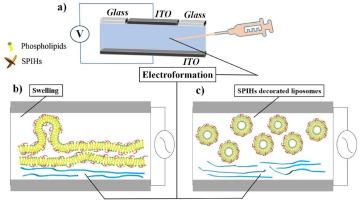Electroformation and characterization of soybean protein isolate hydrolysates-modified liposomes
IF 11
1区 农林科学
Q1 CHEMISTRY, APPLIED
引用次数: 0
Abstract
This research aimed to elucidate the application and feasibility of the enhancement of liposome oxidative stability by the interaction of liposomes with soybean protein isolate hydrolysates (SPIHs) during liposome electroformation. It was observed that the degree of hydrolysis, percentage of low-molecular-weight distribution, and solubility of SPIHs after enzymatic hydrolysis increased with the extension of reaction time. The average fluorescence intensity (average gray level) was approximately 200 a.u. for each liposome, indicating a homogeneous distribution of SPIHs on the liposome surface. Moreover, it was found that the advanced structure of SPIHs incorporated with liposomes was altered appreciably. Both hydrophobic forces and hydrogen bonds exhibited an important role in the interaction between SPIHs and liposomes. In addition, morphology observation indicated that the liposomes were spherical and exhibited a more compact structure after coating with SPIHs. Subsequent flow cytometry analysis showed that the diameter and number of vesicles would increase due to vesicles rupturing or reorganizing after phospholipid oxidation during the electroformation of liposomes to produce SPIHs-liposomes. While the phospholipid oxidation level of the original liposomes was 42.13%, the phospholipid oxidation level of SPIHs-liposomes did not exceed 25%, indicating that the optimal balance between electroformation parameters and phospholipid oxidation level was obtained. These results may provide novel insight into the implications of SPIHs-modified liposomes as functional additives.

大豆分离蛋白水解物改性脂质体的电形成和表征
本研究旨在阐明脂质体电形成过程中脂质体与大豆分离蛋白水解物(SPIHs)相互作用增强脂质体氧化稳定性的应用和可行性。结果表明,随着反应时间的延长,酶水解后的 SPIHs 的水解程度、低分子量分布比例和溶解度均有所增加。每个脂质体的平均荧光强度(平均灰度级)约为 200 a.u.,表明 SPIHs 在脂质体表面分布均匀。此外,研究还发现,与脂质体结合的 SPIHs 的高级结构发生了明显变化。疏水作用力和氢键在 SPIHs 与脂质体的相互作用中都发挥了重要作用。此外,形态学观察表明,涂覆 SPIHs 后的脂质体呈球形,结构更加紧凑。随后的流式细胞仪分析表明,在电形成脂质体以产生 SPIHs 脂质体的过程中,由于磷脂氧化导致囊泡破裂或重组,囊泡的直径和数量会增加。原始脂质体的磷脂氧化水平为 42.13%,而 SPIHs 脂质体的磷脂氧化水平不超过 25%,这表明电形成参数与磷脂氧化水平之间达到了最佳平衡。这些结果可为SPIHs修饰脂质体作为功能添加剂的意义提供新的见解。
本文章由计算机程序翻译,如有差异,请以英文原文为准。
求助全文
约1分钟内获得全文
求助全文
来源期刊

Food Hydrocolloids
工程技术-食品科技
CiteScore
19.90
自引率
14.00%
发文量
871
审稿时长
37 days
期刊介绍:
Food Hydrocolloids publishes original and innovative research focused on the characterization, functional properties, and applications of hydrocolloid materials used in food products. These hydrocolloids, defined as polysaccharides and proteins of commercial importance, are added to control aspects such as texture, stability, rheology, and sensory properties. The research's primary emphasis should be on the hydrocolloids themselves, with thorough descriptions of their source, nature, and physicochemical characteristics. Manuscripts are expected to clearly outline specific aims and objectives, include a fundamental discussion of research findings at the molecular level, and address the significance of the results. Studies on hydrocolloids in complex formulations should concentrate on their overall properties and mechanisms of action, while simple formulation development studies may not be considered for publication.
The main areas of interest are:
-Chemical and physicochemical characterisation
Thermal properties including glass transitions and conformational changes-
Rheological properties including viscosity, viscoelastic properties and gelation behaviour-
The influence on organoleptic properties-
Interfacial properties including stabilisation of dispersions, emulsions and foams-
Film forming properties with application to edible films and active packaging-
Encapsulation and controlled release of active compounds-
The influence on health including their role as dietary fibre-
Manipulation of hydrocolloid structure and functionality through chemical, biochemical and physical processes-
New hydrocolloids and hydrocolloid sources of commercial potential.
The Journal also publishes Review articles that provide an overview of the latest developments in topics of specific interest to researchers in this field of activity.
文献相关原料
公司名称
产品信息
上海源叶
Alkaline proteinase
 求助内容:
求助内容: 应助结果提醒方式:
应助结果提醒方式:


